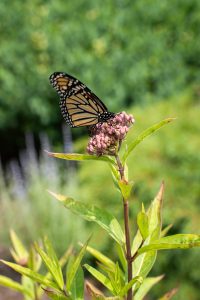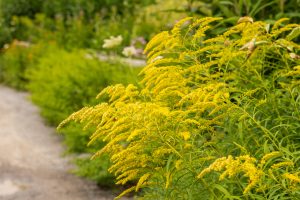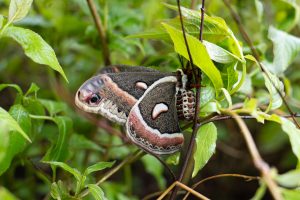Entomologist Zac Smith-Hess discusses easy ways to increase biodiversity in residential yards. Originally published by the Free Press. This article was originally written by Freyja Grey for The Free Press Online, and republished with permission. Photos from Coastal Maine Botanical Gardens.
The circle of life for many of Maine’s threatened and endangered species of insects may begin and end in your garden. Native wildflowers provide a source of food for insects, later becoming a breeding ground and hatching site for eggs. Eventually, both the larval and adult stages of those insects become a vital source of food for predators such as birds.
Zac Smith-Hess, entomologist and educator for Coastal Maine Botanical Gardens, said there are a few easy ways to increase biodiversity in residential yards that both aid these species and help your gardens flourish. “If you have seedlings, now is plenty of time to plant those,” Smith-Hess said, recommending planting native wildflower seeds — his preference for pollinator food — in the autumn, as the underground winter freeze assists spring germination.
“I like to recommend swamp milkweed in particular, the Asclepias incarnata,” he said. “Milkweeds are really great; not only do monarchs rely on them, but there are dozens of specialist species that rely on milkweed to complete their life cycle.” As opposed to generalist species, which can thrive in a broad range of environmental conditions, specialist species have a limited diet dependent on select, native resources, making them more susceptible to extinction. Smith-Hess said one of the reasons he recommends swamp milkweed is that, unlike common milkweed, it is a manageable garden addition and will not spread prolifically.
Swamp milkweed is also known as rose milkweed or rose milkflower and boasts a blush-colored bloom. They blossom from late spring until the end of summer and grow from three to five feet tall. Milkweed is especially recommended in fighting against soil erosion. In addition to being an excellent food source for monarch caterpillars and other species, monarch butterflies prefer the swamp milkweed over other native species for laying their eggs and continuing their life cycle.

Bad Reputations
“Another one that I really like to recommend that gets a super bad reputation, that’s really unearned, is goldenrod,” Smith-Hess said. “A lot of people think they’re allergic to goldenrod; it happens that there’s another species — ragweed — that has a very similar bloom, and it blooms around the same time. The plants look similar … that’s the one people are allergic to. It’s able to be pollinated by insects, it doesn’t have to produce anywhere near as much pollen, and far fewer people are allergic to goldenrod.” Why plant goldenrod? According to Smith-Hess, it supports dozens of specialist native species, and specialist species are the most vulnerable to extinction as their habitats and food sources decline. “They’re really vital for the environment,” Smith-Hess said.
Maine’s current endangered and threatened insect species list includes eight butterflies, two dragonflies, two beetles, two moths, a bumblebee species and more. Another reason to keep goldenrods in your yard is that they become an attractive food source to bugs that may otherwise feast on garden vegetables. “It absolutely does help [fruit and vegetable gardens]; anytime we can build up that biodiversity and build up predator populations, it’s going to cut down on pesticide use,” Smith-Hess said.
Joe-Pye weed is Smith-Hess’s third recommendation for people to grow in their yards and gardens. “It’s funky,” he said. “It forms these really tall, sturdy stems with these beautiful clusters of flowers that are super attractive to bees and really, really attractive to butterflies. The stems are the most important part of that one; if you can leave the stems for two years, a lot of our native bees will actually move into them and that’s where they’re going to raise their young for the course of the summer. “By having these big thick, sturdy stems that last long enough in the environment, we really provide some great habitat for our native bees.”

No yard? No Problem
Various species of milkweed and New England aster are suitable for planting in pots and containers, said Smith-Hess. The New England aster is a native species that sports feathery purple petals with bright orange centers; it has also been used medicinally to treat respiratory illnesses, diarrhea and other maladies. Both the flowers and roots of the aster are used in medicinal tinctures by herbalists.
“It grows really well in pots; it does help to have a little bit of a dryer soil, so a mulch layer on top of the soil could be really helpful,” Smith-Hess said. “Asters are a great one to be grown in pots and container gardens. It also blooms really late into the season, so it’s a great extra food source into late September … a chewed garden is a healthy garden. You want to see some damage on your plants, because it means you’re participating in the environment around you.”
Many insects get a bad reputation, but Smith-Hess said some of the worst offenders are still extremely necessary for our ecosystem. “Nobody likes mosquitoes,” he said. “But the males are actually really important pollinators; they’re nectar feeders. Really, only the females will be drinking blood, generally only once in their life. Most of the time, the females are also nectar feeders.” He noted that lavender has been shown to be effective as a natural mosquito repellent in gardens, but due to their being non-native, other species are less likely to recognize them as a food source. He said some native bee species will still pollinate them, so if you are really trying to reduce your mosquito sightings, lavender is a valid choice.
Tobacco hornworms are another species whose value gets called into question when Smith-Hess gives educational tours at the Coastal Maine Botanical Gardens. Known for devouring whole tomato gardens overnight, the white-striped, spike-tailed green caterpillar is a deeply necessary food source for young birds. “Caterpillars are extremely vital for songbirds,” Smith-Hess said. “A clutch of chickadees needs somewhere between 6,000 and 9,000 caterpillars in order to survive from the time they first hatch out to the time they take their first flight, which is just a massive amount of caterpillars. And those hornworms are perfect; they’re so big, they’re so juicy.
“Nobody wants them on their tomatoes though, so what I like to recommend is having a sacrificial tomato plant somewhere far away from the rest of your tomatoes. Pretty soon, birds figure out where that is, and go after them for you.”
Common Gardening Offenses
“I like to go with the mentality that any little step taken is a great step. A lot of the truly ornamental species [of flowering plants] don’t support many pollinators,” Smith-Hess said, adding that the more we genetically alter plants, the harder it is for insects to identify them as a food source, so sticking with native plants is the best option. “Mowing lawns can be a really big issue,” he said.
“‘No-mow-May’ is a really fantastic thing; I’m glad that so many cities and counties are emphasizing it as a good option, because it is. But, if we let all of this big, beautiful habitat grow and then we cut it all down on June first, we’ve destroyed all that habitat we spent time building. “I like to recommend leaving un-mowed borders, or patches wherever you can let grow as much as you possibly can. Anything from a six-inch-wide border along your back fence to 10-foot wide is going to make a big, appreciable difference.”

Chaos Gardening
Not into high-maintenance yards? The trend of chaos gardening is not only relatively easy and healthy for biodiversity, but as time passes, a chaos garden will thrive through natural selection. Chaos gardening is the practice of taking a diverse mixture of several native plant seeds that do not require deep soil and tossing them across fertile soil. This can be achieved by mixing fruit and vegetable seeds as well. The benefits are numerous, but primary benefits are soil improvement, increased carbon sequestration and growing a natural habitat for birds and insects.
“I love chaos gardening; that’s what I do personally,” Smith-Hess said. “I get my hands on as many native wildflower seeds as I can, and I fill my yard with them. I let whatever grows grow wherever it’s going to be. It’s a great way to simulate what would happen in nature. You might not see a lot of impact in the first year or two, but many seeds can last a very long time in the soil and the seed bank. The more seeds we add to that seed bank, the more likely we’re going to get some of the species that we want to pop up.”
Smith-Hess emphasized that native species are best for ecology, and the more biodiverse an area is, the more species there are thriving in a single habitat, the more resilient that area will be to changes in the ecosystem.
“If we have a system where we only have three or four species and we take one of those out, that system is likely to collapse. If we have a system where we have 30 or 40 species and we take one of those out, well, somebody else [another plant species] is going to be able to move over and fill that niche,” he said.

